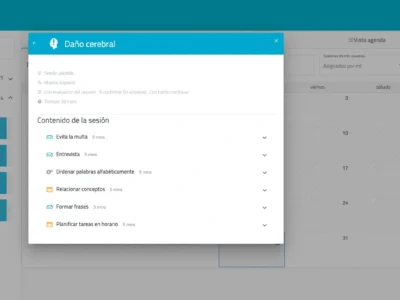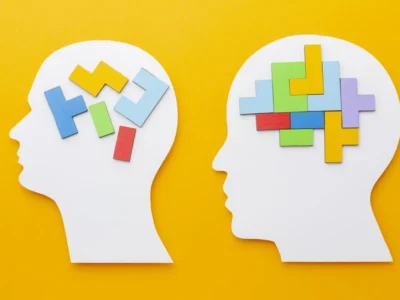Neuropsychologist and researcher Daniela Ramos Usuga explains in this article what divided attention is, the Sohlberg and Mateer clinical model, and the assessment of divided attention.
What is divided attention?
Divided attention is the highest and final level of the hierarchy established by the Sohlberg and Mateer clinical model1, followed by alternating, selective, sustained and focused attention. This type of attention allows us to carry out several tasks simultaneously, commonly known as multitasking.
The initiation of divided attention begins when we perform at the same time two activities that require different responses or cognitive demands, or when the demands are similar but the type of stimulus to attend to differs in each activity.
The Sohlberg and Mateer clinical model
The Sohlberg and Mateer clinical model1, establishes a dependency among the levels of attention, such that the proper functioning of the higher levels depends on the functioning of the lower levels.
When discussing alternating attention, the way its functioning depends on selective, sustained and focused attention was explained. Thus, to establish the subordination of divided attention to the lower levels, it is enough to indicate the close relationship between this type of attention and alternating attention through the words of the authors themselves: “divided attention may reflect a continuous and rapid alternating attention or dependence on a more unconscious automatic processing for at least one of the tasks”2.
This statement indicates that, when carrying out a divided attention task, for example sending a message with a mobile phone while walking down the street, what we do is alternate both activities very quickly, so that we can carry them out simultaneously. They also add that the execution of one of the tasks can be automatic, as is the case with walking.

The previous example highlights the numerous everyday situations in which we engage divided attention and, although we have always been exposed to a large number of stimuli, especially visual and auditory, with the arrival of mobile devices (mobile phone, tablet, e-reader, consoles, etc.) the amount of information we have to process simultaneously has increased.
Thus, a task like driving a car already meant being attentive to various visual stimuli (e.g., traffic signs) and auditory stimuli (e.g., other cars’ horns) at the same time as performing driving behaviors such as accelerating, braking, maintaining direction etc. However, today it is very common to talk on the phone while driving, so cognitive demands increase, requiring the integration and good functioning of attention at all its levels.
Taking into account the great involvement of divided attention in our daily lives, it is not surprising that problems performing multiple tasks simultaneously, which commonly affect people with brain injury, are the ones that most limit return to work or school and reintegration into daily life. For this reason, it is extremely important to include this type of attention in the neuropsychological assessment after a brain injury.
Assessment of divided attention
Generally, when evaluating attention, the most commonly used tests assess sustained attention (e.g., the BTA) and selective attention (e.g., cancellation tasks such as the d2).
On the other hand, in fixed batteries, such as intelligence batteries by Wechsler, attention is evaluated through the Digit Span subtest (sustained attention), and Letter-Number Sequencing (alternating attention)3. The scarcity of instruments for assessing divided attention causes that many times problems in this area are relegated to the background, which in turn leads to incomplete rehabilitation.
One might think that by evaluating the lower levels of attention one can obtain information about divided attention; however, ideally a complete evaluation should be performed, including all levels, especially in cases where the main problem is attentional. For this purpose, the most widely used instrument for assessing divided attention is the Paced Auditory Serial Addition Test (PASAT)4.
In this test the patient is presented, via a CD or cassette, a digit every 3 seconds and their task is to add each new digit to the previous one, so that if the first number is 5 and the second is 2, the correct answer is 7, and if the next number is 8, then the correct answer will be 10 (2+8).
Rehabilitation of attention
As with assessment, one can also conclude that rehabilitating the lower levels automatically leads to improvement in the higher levels, specifically divided attention.
However, attention rehabilitation must be comprehensive, working all levels in a hierarchical manner, so that the rehabilitation or strengthening of each level serves as a “scaffold” for the intervention of the next ones.
As has been indicated on other occasions, the attention rehabilitation program most used in both clinical practice and research is the Attention Process Training (APT), through which sustained, selective, alternating and divided attention are worked on through pencil-and-paper exercises and computerized auditory tasks.
Training of divided attention
Training of divided attention in particular is carried out through three task modalities2:
- Reading for comprehension of a text and searching for a specific stimulus (e.g., the letter h),
- combination of auditory sustained attention tasks with tasks that require a motor response upon the presence of a particular stimulus, evaluating reaction time,
- combination of sustained attention tasks with time monitoring (tracking elapsed time).
The APT, like the NeuronUP platform, which offers multiple exercises to work on different cognitive functions, falls within programs of intervention that act directly on deficits, known as restoration of function.
However, in neuropsychological intervention other procedures can be carried out, which will be applied depending on the clinical characteristics and needs of each patient.
Different types of intervention
Such procedures or types of intervention are not mutually exclusive, in fact, in the majority of cases they should be combined to ensure the best recovery of the patient.
- Compensation/functional adaptation: after a brain injury, and especially in adults, it may not be possible to recover the damaged function, so other less impaired or intact functions are worked on so that they can compensate for the patient’s deficits;
- environmental modifications: it is about adjusting the patient’s environment to favor cognitive functioning. In the case of attention, an environmental modification would be reducing distractors;
- external aids: in case the cognitive function cannot be recovered, the patient is provided with materials that allow them to perform activities of daily living without depending on the damaged function. An example would be the use of a recorder in class for the student with attentional problems.
- family intervention: the cognitive, behavioral and emotional problems of patients with brain injury can mean a burden for relatives and/or caregivers, so it is very important to work with them through the psychoeducation and psychological support. On the other hand, they play an active and essential role in rehabilitation, providing information about the results of the intervention outside the clinic or carrying out activities at home as part of rehabilitation;
- behavioral and emotional interventions: these problems may be the result of organic alterations caused by the injury, or as an emotional reaction to the deficits the patient notices. It is important not to neglect the emotional plane, since it is closely related to cognitive functioning. For example, depressive symptoms can worsen attention problems.
Within behavioral and emotional intervention, work on the motivation deserves special attention, as it is a great ally to drive the rehabilitation or compensation of deficits for several reasons:
- Improves adherence to the intervention.
- Ensures the patient exerts maximum effort to carry out the tasks and obtain better results.
- Allows including tasks outside the clinic in the intervention plan. Once the intervention is completed, it allows the patient to follow recommendations if required.
Guidelines to increase the patient’s motivation
To increase the patient’s motivation it is useful to follow some guidelines, among which the following stand out:
- From the start, establish a rapport with the patient, making them feel comfortable in the clinic and above all giving them the confidence to express all their doubts and emotions,
- be honest with the patient and not give them false hopes. Adjust their expectations to what can be achieved with rehabilitation,
- at the start of the intervention, explain in detail what it is going to consist of, the time it will last and the commitment it requires both on their part and on the therapist’s,
- set clear objectives with the patient both short- and long-term, so that they can evaluate for themselves the results they are obtaining with the intervention,
- before each session, explain to them the purpose of the tasks that are going to be carried out, so that what they do during the intervention makes sense to the patient,
- give them the opportunity to suggest ideas and even to make small decisions, for example, choosing the order of the exercises planned for the session. In this way they will feel they are an active part of the rehabilitation.
Conclusions
Finally, it is necessary to mention that after implementing a neuropsychological rehabilitation program it is recommended to monitor the patient, assessing cognitive, emotional, behavioral functioning and how all this affects quality of life. The latter aspect is especially relevant, since achieving a better quality of life is the ultimate goal of any intervention.
References
- Sohlberg MM, Mateer CA. Effectivenessofanattention-training program. JournalofClinical and Experimental Neuropsychology. 1987;9(2):117–30.
- Sohlberg MM, Mateer CA. ImprovingAttention and ManagingAttentionalProblems. Annalsofthe New York AcademyofSciences. 2006;931(1):359–75.
- Amador J.A. Escala de inteligencia de Wechsler para adultos-IV (WAIS-IV).2013.
- Sherman E.M, Strauss E, Spellacy F. Validityofthe Paced Auditory Serial Addition Test (PASAT) in adultsreferredforneuropsychologicalassessment after head injury. Clin Neuropsych. 1997;11(1):34-45.
If you liked this post, you might also be interested in:
“This article has been translated. Link to the original article in Spanish:”
Rehabilitación de la atención dividida






 The importance of the support network in neurodevelopmental disorders
The importance of the support network in neurodevelopmental disorders
Leave a Reply